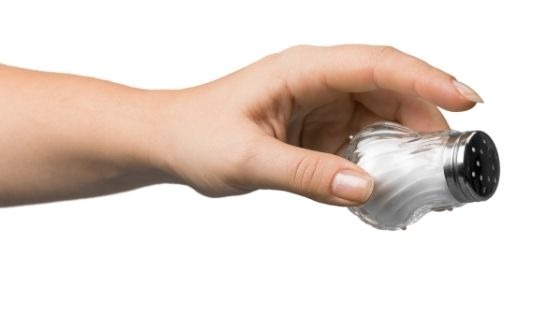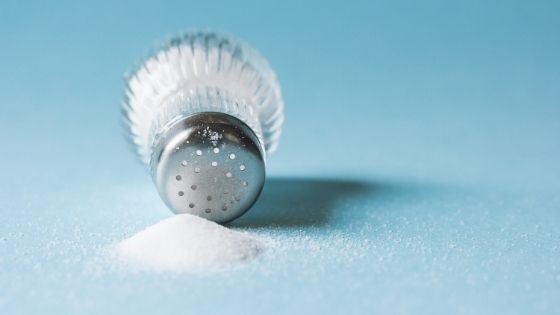How Much Sodium per Day? 5 Dietary Tips to Reduce Salt Intake!

Do you know how much sodium is in your diet? Sodium is a mineral, and it is an essential nutrient that we need to survive. It helps regulate blood pressure and fluid balance, and it's found naturally in many foods.
But too much of it can lead to health problems like high blood pressure, heart disease, stroke, osteoporosis, and kidney stones.
That’s why I created this blog post to help people live healthier lives by educating them about what they put into their bodies.
With this article, you'll learn more about how sodium affects your body so you can make better choices for yourself every day.
What is the Recommended Daily Intake of Sodium?
One's diet can have a significant impact on their health. For example, the American Heart Association recommends no more than 2,300 milligrams (mg) per day and an ideal limit of 1,500 mg for most adults to help keep blood pressure levels low.
The Dietary Guidelines for Americans recommend that children ages 1 through 3 limit their sodium intake to 1200 milligrams per day, 1500 milligrams per day if they are 4-8 years old, and 1800 mg of salt a day when they're 9-13.
How Much Salt is Too Much
According to AHA, a daily sodium intake of more than 2,300 mg per day can be dangerous for your health. Too much sodium can cause salt retention in your body, elevating blood pressure and shortening stroke volume—the amount of blood your body pumps with each contraction.
It's usually safe to get up to 4 grams a day from food alone. It just won't do any good if you also take in another 3 grams through added table salt during cooking or at the table.
But if you're getting more than that, you may want to reduce your intake gradually over time so as not to experience such significant changes too quickly that might send you into shock (like you've just been through a battlefield).
That's why you may want to begin your cuts slowly, adding less table salt and eating more fresh foods.
Tips for Reducing Your Salt Intake

Here are some tips you can use to help you with the process:
Reduce your intake of processed foods
To reduce your processed food intake, you have to avoid most of the packaged & preserved foods you find in your grocery store.
Canned food is usually very high in sodium content and added salt (sodium chloride). They also include additives like sodium bicarbonate or monosodium glutamate (very high in sodium)
Reduce or eliminate your consumption of fast food. You will be surprised how much you can cut out from your daily menu and still enjoy a healthy lifestyle.
Curb your salt habit
If you want to curb your sal habit, you have to get in the habit of reading the Nutrition Facts Label, and you may have to become familiar with phrases like "No salt added," "low sodium," or "very low sodium."
Buy a salt substitute.
There are many substitutes you can try. It's not as good as using less table salt, but you might consider it if you want to cut your intake for a while and don't have time to take on this bigger project.
Don't use salt in your food or cooking indiscriminately; you may need it later.
Eat more fresh fruit & vegetables.
Fruits and vegetables are reduced-sodium foods, and good sources of potassium include beans, legumes (like black-eyed peas), dairy products (like yogurt), and fresh fruit and vegetables. In addition, diets high in potassium can help you retain your body's natural sodium levels, therefore lowering your risk of heart disease.
Always taste first
If you want to know if your meal is too salty, you have to taste it first. Then, before you add more salt, you should be able to judge if you need it or not.
If you're cooking for many people, you may not want to make every meal different, but you can at least try different seasonings and sauces on some dishes (but you'll have to be prepared that your kids may reject you as the cook you were).
When you cook with beans, you can usually reduce the amount of table salt called for in your recipe by 10 percent.
Beans are a good source of potassium to counteract the negative effect high sodium levels have on your blood pressure.
When you are cooking vegetables, you also can reduce your salt intake by cooking them in a mixture of water and vinegar.
Try cutting down 1/8 teaspoon at a time until you can cut out the table salt completely. Once you start, you won't be able to stop because you will notice how good you'll feel when you get your blood pressure back under control.
Risks of consuming too much salt
Hypertension
Hypertension is a disease of the blood vessels that makes the work of the heart and kidneys harder. It affects around 5% of deaths from cardiovascular diseases.
It's a chronic disorder often requiring lifelong treatment, and you can develop other serious illnesses because of it. However, it's mainly caused by stroke and heart attack, two of the most common ways you can die or become disabled.
Stroke or cerebrovascular accident
There are two types of circulatory diseases that you may have a chance of dying from an embolism or a cerebral hemorrhage. However, you may survive a stroke and have some serious physical and neurological problems afterward.
Heart failure and heart attacks
You consume your sodium daily, and you may be having too much salt. Excessive salt consumption could lead to heart disease. The phrase "too much salt" does not mean you have such high levels of sodium that you're at risk for strokes or other health complications. This means you eat a lot more sodium than you need in your diet, and as such, you are at risk for heart diseases such as heart attacks and heart failure.
Excessive salt consumption impairs the function of the kidneys
.The kidneys are also essential for health, as they filter and purify the blood, which is necessary to stay alive. This filtering function is hampered by excessive salt intake and high blood pressure. Not only does excessive salt put someone at risk of forming kidney stones, but it also worsens an already existing condition.
It decreases the amount of calcium.
For those of aging age, osteoporosis can be a debilitating and potentially life-threatening condition. In 2010 alone, 500 k cases were diagnosed in the U.S., leading to 200 000 fractures per year, with most occurring at either hip or spine due to falls.
For your bones not to become more brittle and prone to fracture - we recommend limiting sodium intake! This is because salt consumption leads us to excrete more calcium through urination which leaves our body lacking this vital mineral that helps protect the bone structure against breakages from falling on it (especially if you're over 50!).
Fluid retention
Eating too much sodium causes fluid retention throughout the body that constricts and damages heart, liver, and kidney function in addition to edema (swelling in the legs or ankles).
It favors some types of tumors.
Excessive sodium consumption favors some types of tumors, such as stomach cancer, which can be favored by excessive salt consumption.
In large quantities, it can be an irritant that erodes the stomach lining, causing ulcerous lesions infections predisposing to the presentation of gastric tumors.
It hinders the function of the respiratory system
When people reduce their salt intake, they experience a decrease in the severity of asthma symptoms. Doctors also point out that too much sodium can worsen this respiratory condition and cause it to be more difficult for patients with severe cases to breathe normally or take medications as prescribed.
It favors overweight and obesity:
Since salt intake increases thirst, this tries to be quenched with sugary and energetic drinks, such as soft drinks, whose continued and excessive consumption unbalances the balance between calories ingested and calories consumed, predisposing to overweight and obesity.
Obesity is also a disease that causes and negatively influences the aforementioned diseases of the circulatory system (heart attacks and strokes), kidney, respiratory system, various types of tumors, musculoskeletal system (osteoporosis, osteoarthritis), etc...
High sodium foods
- Bagel, plain 1 oz: 2.095 mg (64.8%DV)
- Rye bread, pumpernickel 1 slice: 2.216 mg (66%DV)
- White or wheat bread, 1 slice: 0.35 mg (12%DV)
- White or wheat bread, 2 slices: 0.7 mg (24%DV)
- Whole wheat bread, 1 slice: 0.503 mg (19%DV)
- White bread, 1 slice: 0.499 mg (19%DV
- Cornbread, yellow, pre-cooked 1 oz: 0.559 mg (22%DV)
- Wheat germ, toasted 10 dry tbsp: 2.976 mg (97%DV)
- Bread stuffing, chicken flavor, prepared with equal volume water 1.5 oz: 2.219 mg (65%DV)
Low sodium foods
- Soya milk, calcium-fortified 1 cup: 22.2 mg (10%DV)
- Instant dry milk, nonfat 1 tbsp: 0.099 mg (4%DV)
- Yogurt, nonfat, plain 8 oz: 4.3 mg (16%DV)
- Fresh sweet corn on the cob, 1 medium ear: 0.141 mg (5%DV)
- Nonfat milk, calcium-fortified 8 oz: 102.2 mg (40%DV)
- Honey 2 tbsp: 131.3 mg (55%DV)
- Instant dry milk, nonfat 1 cup: 200.9 mg (80%DV)
- Milk, nonfat 8 oz: 205.7 mg (82%DV)
- Sweet corn, canned 1 cup: 226.9 mg (90%DV)
- Whole milk 8 oz: 260.8 mg (102%DV)
- Yogurt, plain, low-fat fruit 8 oz: 410.9 mg (162%DV)
- Cheese, cottage 0.5 cup: 419.6 mg (164%DV)
- Cocoa powder 2 tbsp: 515.4 mg (210%DV)
- Sunflower seeds 1 oz: 663.5 mg (266%DV)
Now that you know how unhealthy too much sodium can be, you should no longer have trouble resisting it.
But, on the contrary, you may find yourself enjoying lower sodium foods more than the ones you used to eat.
Conclusion
The research is inconclusive, but it seems like a good rule of thumb to keep your sodium intake below 2 (2,000 mg) grams per day. So what’s the amount of salt you consume on a typical day?
Have you been eating more than 2g/day on average and not known about it? Then, it might be time for some personal reflection! For instance, removing the salt shaker from your sight.
If this post has inspired you to make any changes, please let us know how they go by commenting below. We care about what we eat too! (Trusted sources 1*, 2*, 3*, 4*).
Medically reviewed and approved by Nataniel Josue M D.
